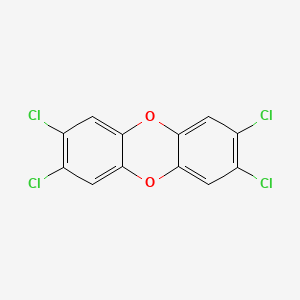D0234 | TCDD
| Pictogram | Signal | Statements | Precautionary Statement Codes |
|---|---|---|---|
   |
Danger |
Aggregated GHS information provided by 38 companies from 1 notifications to the ECHA C&L Inventory. Each notification may be associated with multiple companies. H300 (100%): Fatal if swallowed [Danger Acute toxicity, oral] H319 (100%): Causes serious eye irritation [Warning Serious eye damage/eye irritation] H400 (100%): Very toxic to aquatic life [Warning Hazardous to the aquatic environment, acute hazard] H410 (100%): Very toxic to aquatic life with long lasting effects [Warning Hazardous to the aquatic environment, long-term hazard] Information may vary between notifications depending on impurities, additives, and other factors. The percentage value in parenthesis indicates the notified classification ratio from companies that provide hazard codes. Only hazard codes with percentage values above 10% are shown. |
P264, P270, P273, P280, P301+P310, P305+P351+P338, P321, P330, P337+P313, P391, P405, and P501; (The corresponding statement to each P-code can be found at the GHS Classification page.) |
    |
Danger |
H225: Highly Flammable liquid and vapor [Danger Flammable liquids] H304: May be fatal if swallowed and enters airways [Danger Aspiration hazard] H315: Causes skin irritation [Warning Skin corrosion/irritation] H319: Causes serious eye irritation [Warning Serious eye damage/eye irritation] H336: May cause drowsiness or dizziness [Warning Specific target organ toxicity, single exposure Narcotic effects] H361: Suspected of damaging fertility or the unborn child [Warning Reproductive toxicity] H373: Causes damage to organs through prolonged or repeated exposure [Warning Specific target organ toxicity, repeated exposure] H400: Very toxic to aquatic life [Warning Hazardous to the aquatic environment, acute hazard] H410: Very toxic to aquatic life with long lasting effects [Warning Hazardous to the aquatic environment, long-term hazard] |
P201, P202, P210, P233, P240, P241, P242, P243, P260, P261, P264, P271, P273, P280, P281, P301+P310, P302+P352, P303+P361+P353, P304+P340, P305+P351+P338, P308+P313, P312, P314, P321, P331, P332+P313, P337+P313, P362, P370+P378, P391, P403+P233, P403+P235, P405, and P501; (The corresponding statement to each P-code can be found at the GHS Classification page.) |
   |
Danger |
H300: Fatal if swallowed [Danger Acute toxicity, oral] H310: Fatal in contact with skin [Danger Acute toxicity, dermal] H315: Causes skin irritation [Warning Skin corrosion/irritation] H319: Causes serious eye irritation [Warning Serious eye damage/eye irritation] H341: Suspected of causing genetic defects [Warning Germ cell mutagenicity] H350: May cause cancer [Danger Carcinogenicity] H360: May damage fertility or the unborn child [Danger Reproductive toxicity] H370: Causes damage to organs [Danger Specific target organ toxicity, single exposure] H372: Causes damage to organs through prolonged or repeated exposure [Danger Specific target organ toxicity, repeated exposure] |
P201, P202, P260, P262, P264, P270, P280, P281, P301+P310, P302+P350, P302+P352, P305+P351+P338, P307+P311, P308+P313, P310, P314, P321, P322, P330, P332+P313, P337+P313, P361, P362, P363, P405, and P501; (The corresponding statement to each P-code can be found at the GHS Classification page.) |
| 1746-01-6 | 2,3,7,8-:tetrachlorodibenzo-p-dioxin | 2,3,7,8-Czterochlorodwubenzo-p-dwuoksyny |
| 2,3,7,8-Czterochlorodwubenzo-p-dwuoksyny [Polish] | 2,3,7,8-T4CDD | 2,3,7,8-TCDD |
| 2,3,7,8-TETRACHLORODIBENZO-P-DIOXIN | 2,3,7,8-TETRACHLORODIBENZO-P-DIOXIN (SEE ALSO TRANSGENIC MODEL EVALUATION (2,3,7,8-TETRACHLORODIBENZODIOXIN)) | 2,3,7,8-Tetra polychlorinated dibenzo-p-dioxin |
| 2,3,7,8-Tetrachloro-Dibenzo[1,4]Dioxine | 2,3,7,8-Tetrachloro-dibenzo[b,e][1,4]dioxin | 2,3,7,8-Tetrachloro-p-dioxin |
| 2,3,7,8-Tetrachlorodibenzo(b,e)(1,4)dioxan | 2,3,7,8-Tetrachlorodibenzo(b,e)(1,4)dioxin | 2,3,7,8-Tetrachlorodibenzo-1,4-dioxin |
| 2,3,7,8-Tetrachlorodibenzo-p-dioxin 10 microg/mL in Toluene | 2,3,7,8-Tetrachlorodibenzo-p-dioxin [Dioxin and dioxin-like compounds] | 2,3,7,8-Tetrachlorodibenzo[b,e][1,4]dioxin |
| 2,3,7,8-Tetrachlorodibenzodioxin | 2,3,7,8-Tetrachlorooxanthrene | 2,3,7,8-Tetrachlorooxanthrene # |
| 2,3,7,8-tetrachloro-dibenzo-p-dioxin | 2,3,7,8-tetrachlorodibenzo[b,e][1,4]dioxine | 2,3,7,8-tetrachlorodibenzodioxine |
| 56795-67-6 | AKOS022181518 | BDBM23927 |
| BRD-K90697689-001-01-5 | BRN 0271116 | C07557 |
| CAS-1746-01-6 | CCRIS 576 | CHEBI:28119 |
| CHEMBL30327 | CTK5A5713 | DO80M48B6O |
| DSSTox_CID_1315 | DSSTox_GSID_21315 | DSSTox_RID_76075 |
| DTXSID2021315 | Dibenzo(b,e)(1,4)dioxin, 2,3,7,8-tetrachloro- | Dibenzo-p-dioxin, 2,3,7,8-tetrachloro- |
| Dibenzo[b,e][1,4]dioxin, 2,3,7,8-tetrachloro- | Dioksyny | Dioksyny [Polish] |
| Dioxin | Dioxin (herbicide contaminant) | Dioxin mixture |
| Dioxine | EINECS 217-122-7 | FT-0674944 |
| GTPL9642 | HGUFODBRKLSHSI-UHFFFAOYSA-N | HSDB 4151 |
| LS-938 | MFCD00152860 | NCGC00260338-01 |
| NCI-C03714 | PCDD 48 | Q52822 |
| SCHEMBL8939 | TCDB D | TCDBD |
| TCDD | TEF TRANSGENICS (TCDD) | TOXIC EQUIVALENCY FACTOR EVALUATION (TCDD) (SEE ALSO TCDD & TRANSGENIC MODEL EVALUATION) |
| TRANSGENIC MODEL EVALUATION (2,3,7,8-TETRACHLORODIBENZODIOXIN) | Tetrachlorodibenzo-1,4-dioxin | Tetrachlorodibenzodioxin |
| Tetradioxin | Tox21_202792 | UNII-DO80M48B6O |
| UNII-OHF2F5C0ZH component HGUFODBRKLSHSI-UHFFFAOYSA-N | Y1783 | ZINC897030 |
| [3H]-TCDD | dibenzo-dioxin, 2,3,7,8-tetrachlorinated |
| CAS Number | 114320-51-3, 1746-01-6, 56795-67-6 |
| PubChem Compound | 15625 |
| KEGG Compound ID | C07557 |
| PharmGKB | 28119 |
| ChemSpider | 14865 |
| Wikipedia | 2,3,7,8-Tetrachlorodibenzodioxin |

